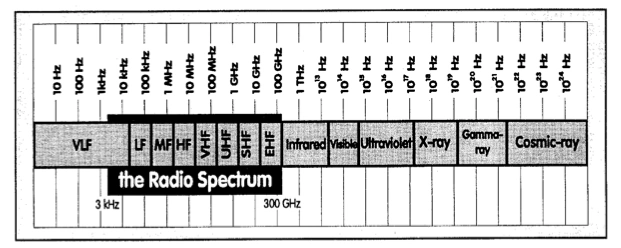Definition[]
The radio spectrum is "the full range of frequencies suitable for radio communication."[1]
Overview[]
The radio spectrum is "the part of the electromagnetic spectrum corresponding to radio frequencies — that is, frequencies lower than around 300 GHz (or, equivalently, wavelengths longer than about 1 mm)."[2]
It is segmented into bands of radio frequencies and typically measured in cycles per second, or hertz.[3]
The width of the radio spectrum is called the bandwidth of the signal. More broadly, the radio frequency spectrum consists of all the radio frequencies used for radio communications.
Radio spectrum in the United States has been assigned to a variety of services, including commercial mobile radio service, private mobile radio, satellite services, mobile wireless services and fixed wireless services, including broadcast broadband access, point-to-point and backhaul services. "The primary bands in the United States are at 700 megahertz (MHz), 800 MHz, 1.8–1.9 GHz, 1.4 GHz, 1.7 GHz, 2.1 GHz, and 2.4–2.6 GHz.[4]
"To achieve maximum use of the spectrum, the Federal Communications Commission has prescribed rules and regulations to be followed by licensed radio operators and authorized radio stations. Scrupulous observance of these rules and regulations is necessary to prevent harmful radio interference."[5]
References[]
- ↑ Information on Management and Use of the Radio Frequency Spectrum - A Little-Understood Resource, at 1.
- ↑ Autonomous Vehicle Technology: A Guide for Policymakers, at 77 n.1.
- ↑ Standard abbreviations for measuring frequencies include kHz: kilohertz or thousands of hertz; MHz: megahertz, or millions of hertz; and GHz: gigahertz, or billions of hertz.
- ↑ Mobile phones used in Europe, Latin America, and elsewhere operate in the 400 MHz, 800 MHz, 900 MHz, 1.8 GHz, and 1.9 GHz bands.
- ↑ Information on Management and Use of the Radio Frequency Spectrum - A Little-Understood Resource, at 1.
